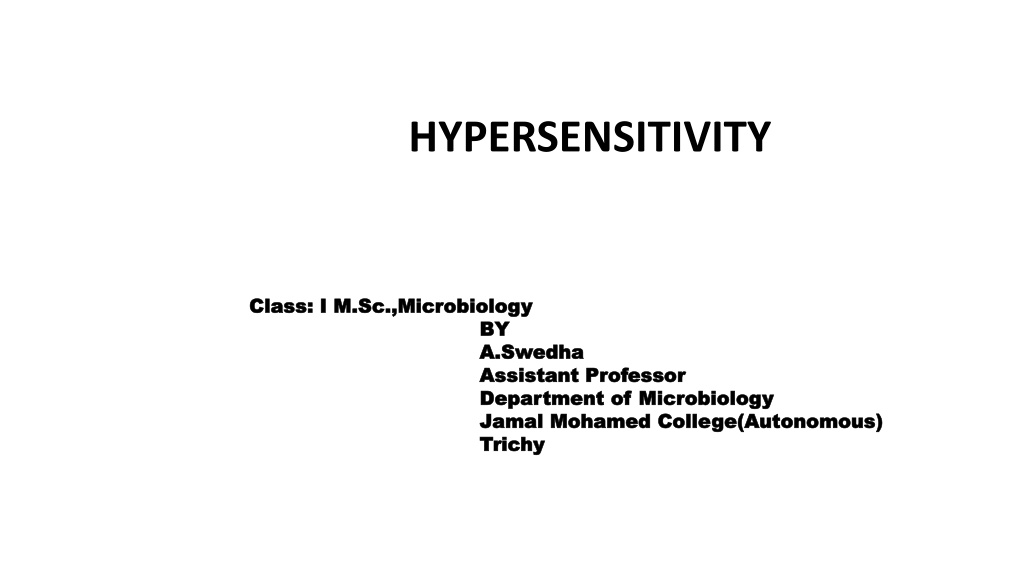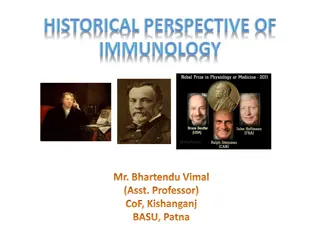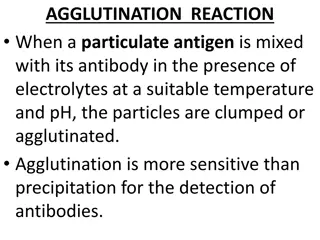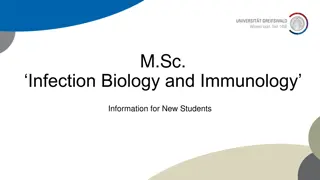Understanding Hypersensitivity Reactions in Immunology
Hypersensitivity in immunology refers to an altered immune response against antigens, leading to hyperreactivity and immunopathology. This article delves into the different categories of adaptive hypersensitivities, focusing on Immediate (Type I), Antibody-Mediated Cytotoxic (Type II), and Immune Complex-Mediated (Type III) hypersensitivity reactions. Detailed characteristics, triggers, and diagnostic approaches for each type are discussed, providing insights into the complex mechanisms behind these immune responses.
Download Presentation

Please find below an Image/Link to download the presentation.
The content on the website is provided AS IS for your information and personal use only. It may not be sold, licensed, or shared on other websites without obtaining consent from the author. Download presentation by click this link. If you encounter any issues during the download, it is possible that the publisher has removed the file from their server.
E N D
Presentation Transcript
HYPERSENSITIVITY Class: I Class: I M.Sc.,Microbiology M.Sc.,Microbiology BY BY A A. .Swedha Swedha Assistant Assistant Professor Department Department of Jamal Jamal Mohamed Mohamed College(Autonomous) College(Autonomous) Trichy Trichy Professor of Microbiology Microbiology
INTRODUCTION Hypersensitivity can be defined as a state of altered immune response against an antigen characterized by hyper reactivity leading to immunopathology Hypersensitivity reactions require a pre-sensitized (immune) state of the host. There are two categories of adaptive hypersensitivities: Immediate hypersensitivities refer to humoral immunity (antigen/antibody reactions) Delayed hypersensitivities refer to cell-mediated immunity(cytotoxic T- lymphocytes, macrophages, and cytokines)
Characteristics of Type-I hypersensitivity It is also known as immediate or anaphylactic hypersensitivity and is mediated by IgE. The reaction occurs on exposure to allergen second time. The first exposure (sensitizing dose) results in sensitization of host to allergen and subsequent exposure (s) (shocking dose) will cause reaction Anaphylactic shock occurs in sensitized animals within seconds to minutes (15-30after exposure to the allergen) after exposure to the antigen, now called as an allergen. Sometimes the reaction may have a delayed onset (10-12 hours). In type I hypersensitivity reactions, the allergens are proteins with a molecular weight ranging from 10 to 40 kDa. Diagnostic tests for immediate hypersensitivity include skin (prick and intradermal) tests resulting in wheal and flare reaction, measurement of total IgE and specific IgE antibodies against the suspected allergens by ELISA, Radioallergosorbent test (RAST)
Characteristics of Type II Hypersensitivity Type II hypersensitivity are antibody mediated cytotoxic reactions occurring when an antibody binds to antigens located on the surface of cells (usually RBCs). The reaction time is minutes to hours. It is mediated, primarily, by antibodies of IgM or IgG class. The bound antibody can cause cell lysis by activating the classical complement pathway, promoting phagocytosis (opsonization) or through ADCC. Many different antigens may trigger this cell destruction, but an infection in a genetically predisposed animal appears to be a major triggering pathway. Antigens are normally endogenous, although exogenous chemicals (haptens, such as ivy or drugs) that can attach to cell membranes can also induce type II reactions. Autoimmune haemolytic anaemia, Blood transfusion reactions, Erythroblastosis fetalis, drug- induced hemolytic anemia, granulocytopenia and thrombocytopenia are examples
Characteristics of Type III Hypersensitivity In type III hypersensitivity, soluble immune complexes are formed in blood and are deposited in various tissues (typically the skin, kidney and joints), activate classical complement pathway and cause inflammatory damage. It is mediated by soluble immune complexes. They are mostly of IgG class, although IgM may also be involved. The reaction takes hours to days (3-10 hours) to develop. The antigen may be exogenous (chronic bacterial, viral or parasitic infections), or endogenous (non-organ specific autoimmunity: e.g., Systemic Lupus Erythematosus-SLE). The antigen is soluble and not attached to the organ involved. The prerequisite for the development of immune-complex disease is the persistent presence of soluble antigen and antibody
Characteristics of Type IV Hypersensitivity Type IV hypersensitivity is often called delayed type hypersensitivity as the reaction takes more than 12 hours to develop. Typically the maximal reaction time occurs between 48 to 72 hours It is mediated by cells that cause an inflammatory reaction to either exogenous or autoantigens The major cells involved are T lymphocytes and monocytes/macrophages. This reaction to exogenous antigens involves T cells and also antigen-presenting cells (APC), all produce cytokines that stimulate a local inflammatory response in a sensitized individual. DHR cannot be transferred from an animal to another by means of antibodies or serum. However, it can be transferred by T cells, particularly CD4 Th1 cells























